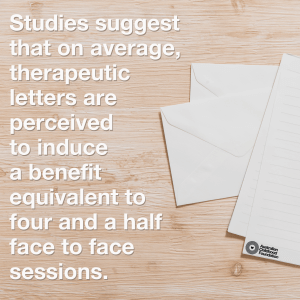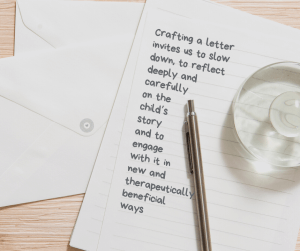
Yours Truly: Incorporating Therapeutic Letters into the Assessment Process with Children and Young People
Laura Pyle, highlights how staff have been able to use letter writing as an effective tool in therapeutic work with children and young people.
This blog article was written by Laura Pyle, a Team Leader in the Australian Childhood Foundation’s Therapeutic Services.
In our Therapeutic Services program in Victoria, a group of us have recently been thinking about the way we document the rich stories of children’s lives which emerge throughout our therapeutic assessment process. In particular, we have been pondering the important question of how we best share our assessment with the children whose stories we now hold.
A concept we have been focusing on is therapeutic letter-writing, and how this can be used in a purposeful way at the conclusion of an assessment period.
The Write Stuff: Therapeutic Letters as a Vehicle for Story-Telling
Letter-writing has been used widely and variedly as a contribution to the therapeutic process, particularly within the field of Narrative Therapy, as captured in the work of Michael White and David Epston. In this context, it’s origins have been linked back to cultural anthropologists such as Barbara Myerhoff, who identified the nourishing experience of having our stories fed back to us by others (White, 2000). Therapeutic letters can be powerful tools for consolidating emerging alternative narratives about children’s lives and can help to position children as witnesses to their own abilities or values which may have been forgotten or concealed as a consequence of trauma. The reciprocity of the letter-writing process also allows for mutual trust and respect to develop, enhancing the therapeutic relationship (Bjoroy et al, 2016).
 Whilst there has been minimal formal evaluation of the benefits of therapeutic letter-writing, informal clinical research and small-scale studies suggest that clients report that the technique contributes significantly to the positive outcomes of therapy. The studies suggest that on average, therapeutic letters are perceived to induce a benefit equivalent to four and a half face to face sessions (Epston, 2018).
Whilst there has been minimal formal evaluation of the benefits of therapeutic letter-writing, informal clinical research and small-scale studies suggest that clients report that the technique contributes significantly to the positive outcomes of therapy. The studies suggest that on average, therapeutic letters are perceived to induce a benefit equivalent to four and a half face to face sessions (Epston, 2018).
Writing a letter following completion of a therapeutic assessment report is an opportunity to share our emerging understandings of the child and their story directly with them. It creates an opportunity to provide the child with an experience of being seen, understood and accepted. A letter may also support the transition from assessment phase into intervention, by clearly communicating our understanding of the child’s needs and goals, and our thoughts about what might help to meet these.
Putting Pen to Paper: What to Include?
A therapeutic letter should start with an introductory paragraph re-connecting the child to us and our role/contact with them. We should also anticipate the child’s curiosity and include some brief information about the assessment process (how did we come to hold the understanding of the child which the letter describes?). Including a mention of something which speaks to the relationship between ourselves and the child – such as a shared joyful moment or a favourite mutual activity, will assist to orient the child to whose words they are reading, and set a positive tone for the correspondence to come.
Each therapeutic letter we write will be as unique and individual as the children we are corresponding with. With this importance of tailoring content in mind, following our introduction some of the things we may seek to include could be:
- Describing our understanding of the key themes from the child’s experiences
- Acknowledging things which remain hard for the child and the difficulties these create in their life.
- Wondering about parts of the child’s story and experiences which may remain unknown or confusing (to us and/or to the child)
- Identifying and celebrating the strengths and resources within and around the child
- Validating goals or hopes expressed by the child
- Describing for the child our understanding of what they might need from us and/or from other important people in their life to manage the hard things and make progress towards goals.
It is worth noting that for some children it may be simply too much to include all of these aspects into one single letter. We may consider sharing one or two of our thoughts at a time and gauging how the child responds, potentially weaving a series of letters throughout the intervention that follows assessment.
When writing a therapeutic letter we must be mindful to use language which matches the child’s developmental age and comprehension abilities. Using specific language or metaphors about the child, their world and their experiences which have emerged through the assessment process – in particular verbatim quotes from children themselves or special people in their lives, can be particularly powerful.
Signed, Sealed, Delivered: Maximising Benefits
When writing a therapeutic letter for a child, we should also consider how we will invite and support them to respond and give feedback on their experience of reading it. How can we position children as the editors-in-chief of their own stories? We may enquire if anything in the letter stood out to them, ask if there are things that they would take out or if they think we have missed something important. This message can be included in the letter and reinforced at our next meeting with the child.
 Depending on the child’s circumstances, identified needs and our role, in addition to sharing our therapeutic letter with the child, we may consider the benefits of sharing such documents with other important people in the child’s world, such as a parent, carer or teacher. Therapeutic letters may prove helpful in supporting people around the child to hold a narrative which increases their empathy, understanding and ability to respond therapeutically to the child’s needs. Ensuring that everyone supporting the child holds a congruent narrative is also crucial in working towards greater integration for the child. Wherever possible, we should approach sharing a therapeutic letter with others as something which is undertaken in partnership with, rather than on behalf of the child.
Depending on the child’s circumstances, identified needs and our role, in addition to sharing our therapeutic letter with the child, we may consider the benefits of sharing such documents with other important people in the child’s world, such as a parent, carer or teacher. Therapeutic letters may prove helpful in supporting people around the child to hold a narrative which increases their empathy, understanding and ability to respond therapeutically to the child’s needs. Ensuring that everyone supporting the child holds a congruent narrative is also crucial in working towards greater integration for the child. Wherever possible, we should approach sharing a therapeutic letter with others as something which is undertaken in partnership with, rather than on behalf of the child.
P.S. One Last Thought!
One final but important thought! Therapeutic letter-writing will likely also have significant benefits for us as practitioners. We all know the pressure of juggling workloads and deadlines that can surround processes such as assessment. At times we become so focused on the endpoint (just get the damn report written!) that we may be at risk of losing sight of the value of the journey we have embarked upon alongside children and their families. Crafting a letter invites us to slow down, to reflect deeply and carefully on the child’s story and to engage with it in ways which are likely to have great benefits to the way we then engage with the child and the people around them.
References
- Bjoroy, A., Madigan, S. and Nyland, D., (2016) The Practice of Therapeutic Letter Writing in Narrative Therapy, in The Handbook of Counselling Psychology, Sage Publications Ltd
- Epston, D. (2018) Introduction by David Epston about this Special Release, in Journal of Narrative Family Therapy: Ideas and Practices in the Making; Special Release on Innovative Therapeutic Documentation in Narrative Therapy, www.JournalNFT.com
- White, M. (2000) Chapter 4: Reflecting-team work as definitional ceremony revisited in Reflections on Narrative Practices: Interviews and Essays, Adelaide, Dulwich Centre Publications
